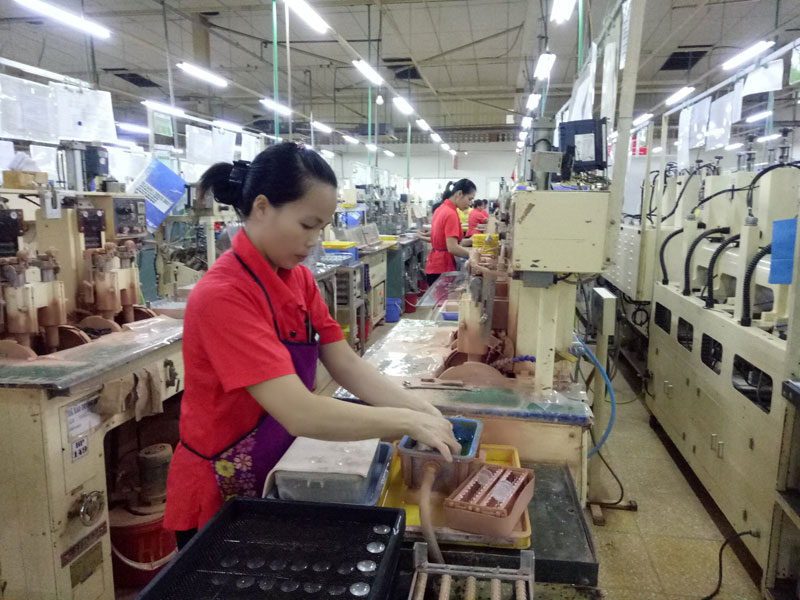
(HBO) - The process of extensive international economic integration has created favourable conditions for foreign businesses to invest in projects in the northwestern mountainous province of Hoa Binh, helping to promote the locality’s economic growth.
 Production and business
activities of the R Technical Research Co., Ltd in the Da River left-bank industrial park in Hoa Binh
city have contributed to promoting Hoa Binh province’s export value.
Production and business
activities of the R Technical Research Co., Ltd in the Da River left-bank industrial park in Hoa Binh
city have contributed to promoting Hoa Binh province’s export value.
Since 2017, the province has attracted 17 foreign direct investment (FDI)
projects with total capital of about 275.7 million USD.
The locality is now home to 40 FDI projects with total registered capital of 580.2
million USD, of which 33 projects have been put into operation.
Foreign enterprises are mainly from the Republic of Korea, Japan, and China,
operating in the field of electronic component assembly and garment.
The attraction of official
development assistance (ODA) in Hoa Binh has
been promoted. In the last three years, the province has had 26 programmes and projects using ODA capital and preferential loans
from foreign donors.
The provinceis calling for a number of ODA projects, including a green urban development project to adapt to climate change in Ky Son ward of Hoa Binh city; a project to connect the
province’s transport networks to the national transport system.
Local authorities have also paid attention to attracting and mobilising foreign
non-governmental aid. Non-governmental organisations (NGOs) have so far
operated at all of the province’s districts and Hoa Binh city, mainly in areas
with disadvantaged socio-economic conditions and in the fields of rural
development, health care, education, clean water and environmental sanitation,
and in solving social problems.
Hoa Binh authorities have been implementing well commitments and
international agreements signed with organisations, agencies and foreign
localities such as World Vision, ChildFund, Habitat for Humanity International, AOP, AEA, German bank for reconstruction (KfW), KuwaitFundforArab Economic Development, KV Consulting Co., Ldt, Hanbaek Construction Co., Ltd, Luang Prabang and Huophane
provinces of Laos, TUV province of Mongolia, Jeollabuk and Ulsan city’s Ulju district of the
Republic of Korea. These help create good relations with partners.
The province
is now home to 49 programmes and projects funded by 21 NGOs, development
cooperation agencies and donors with total committed aid value of 15.8 million
USD.
The committed value of new programmes and projects in the first six months of
this year was over 2.2 million USD. There are 22 international agreements being
carried out in the province./.
According to data from the Hoa Binh Provincial Party Committee, the industrial production index for the first six months of 2025 is estimated to have increased by 20% compared to the same period last year. This marks the highest year-on-year growth rate for this period since 2020.
In the first six months of 2025, Hoa Binh province’s export turnover was estimated at 1.145 billion USD, marking an 18.11% increase compared to the same period in 2024. Import turnover was estimated at $ 804 million, a 17.15% increase, which helped the province maintain a positive trade balance.
The lives of the ethnic minority farmers in Tan Lac district have gradually improved thanks to the new directions in agricultural production. This is a testament to the collective strength fostered through the professional associations and groups implemented by various levels of the district’s Farmers’ Union.
With the motto the "product quality comes first,” after nearly one year of establishment and operation, Muong village’s Clean Food Agricultural and Commercial Cooperative, located in Cau Hamlet, Hung Son Commune (Kim Boi district), has launched reputable, high-quality agricultural products to the market that are well-received by consumers. The products such as Muong village’s pork sausage, salt-cured chicken, and salt-cured pork hocks have gradually carved out a place in the market and they are on the path to obtaining the OCOP certification.
In the past, the phrase "bumper harvest, rock-bottom prices" was a familiar refrain for Vietnamese farmers engaged in fragmented, small-scale agriculture. But today, a new spirit is emerging across rural areas of Hoa Binh province - one of collaboration, organisation, and collective economic models that provide a stable foundation for production.
Maintaining growing area codes and packing facility codes in accordance with regulations is a mandatory requirement for agricultural products to be eligible for export. Recently, the Department of Agriculture and Environment of Hoa Binh province has intensified technical supervision of designated farming areas and packing facilities to safeguard the "green passport" that enables its products to access international markets.



 Production and business
activities of the R Technical Research Co., Ltd in the Da River left-bank industrial park in Hoa Binh
city have contributed to promoting Hoa Binh province’s export value.
Production and business
activities of the R Technical Research Co., Ltd in the Da River left-bank industrial park in Hoa Binh
city have contributed to promoting Hoa Binh province’s export value.